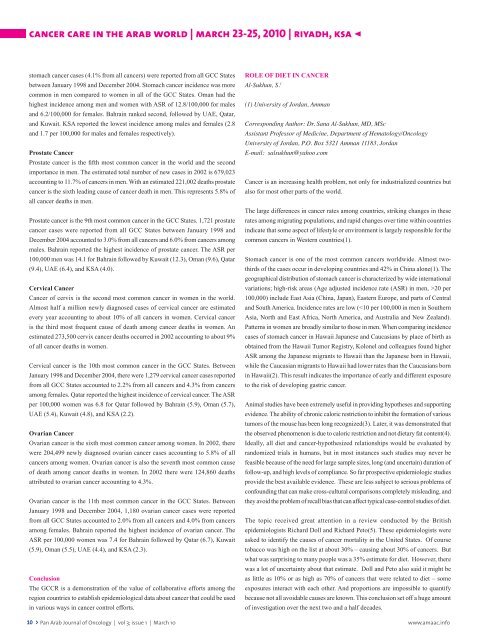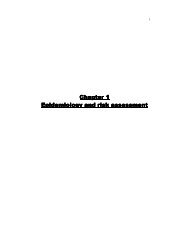Pan Arab Journal of Oncology - Arab Medical Association Against ...
Pan Arab Journal of Oncology - Arab Medical Association Against ...
Pan Arab Journal of Oncology - Arab Medical Association Against ...
Create successful ePaper yourself
Turn your PDF publications into a flip-book with our unique Google optimized e-Paper software.
cancer care in the arab world | march 23-25, 2010 | riyadh, ksa <<br />
stomach cancer cases (4.1% from all cancers) were reported from all GCC States<br />
between January 1998 and December 2004. Stomach cancer incidence was more<br />
common in men compared to women in all <strong>of</strong> the GCC States. Oman had the<br />
highest incidence among men and women with ASR <strong>of</strong> 12.8/100,000 for males<br />
and 6.2/100,000 for females. Bahrain ranked second, followed by UAE, Qatar,<br />
and Kuwait. KSA reported the lowest incidence among males and females (2.8<br />
and 1.7 per 100,000 for males and females respectively).<br />
Prostate Cancer<br />
Prostate cancer is the fifth most common cancer in the world and the second<br />
importance in men. The estimated total number <strong>of</strong> new cases in 2002 is 679,023<br />
accounting to 11.7% <strong>of</strong> cancers in men. With an estimated 221,002 deaths prostate<br />
cancer is the sixth leading cause <strong>of</strong> cancer death in men. This represents 5.8% <strong>of</strong><br />
all cancer deaths in men.<br />
Prostate cancer is the 9th most common cancer in the GCC States. 1,721 prostate<br />
cancer cases were reported from all GCC States between January 1998 and<br />
December 2004 accounted to 3.0% from all cancers and 6.0% from cancers among<br />
males. Bahrain reported the highest incidence <strong>of</strong> prostate cancer. The ASR per<br />
100,000 men was 14.1 for Bahrain followed by Kuwait (12.3), Oman (9.6), Qatar<br />
(9.4), UAE (6.4), and KSA (4.0).<br />
Cervical Cancer<br />
Cancer <strong>of</strong> cervix is the second most common cancer in women in the world.<br />
Almost half a million newly diagnosed cases <strong>of</strong> cervical cancer are estimated<br />
every year accounting to about 10% <strong>of</strong> all cancers in women. Cervical cancer<br />
is the third most frequent cause <strong>of</strong> death among cancer deaths in women. An<br />
estimated 273,500 cervix cancer deaths occurred in 2002 accounting to about 9%<br />
<strong>of</strong> all cancer deaths in women.<br />
Cervical cancer is the 10th most common cancer in the GCC States. Between<br />
January 1998 and December 2004, there were 1,279 cervical cancer cases reported<br />
from all GCC States accounted to 2.2% from all cancers and 4.3% from cancers<br />
among females. Qatar reported the highest incidence <strong>of</strong> cervical cancer. The ASR<br />
per 100,000 women was 6.8 for Qatar followed by Bahrain (5.9), Oman (5.7),<br />
UAE (5.4), Kuwait (4.8), and KSA (2.2).<br />
Ovarian Cancer<br />
Ovarian cancer is the sixth most common cancer among women. In 2002, there<br />
were 204,499 newly diagnosed ovarian cancer cases accounting to 5.8% <strong>of</strong> all<br />
cancers among women. Ovarian cancer is also the seventh most common cause<br />
<strong>of</strong> death among cancer deaths in women. In 2002 there were 124,860 deaths<br />
attributed to ovarian cancer accounting to 4.3%.<br />
Ovarian cancer is the 11th most common cancer in the GCC States. Between<br />
January 1998 and December 2004, 1,180 ovarian cancer cases were reported<br />
from all GCC States accounted to 2.0% from all cancers and 4.0% from cancers<br />
among females. Bahrain reported the highest incidence <strong>of</strong> ovarian cancer. The<br />
ASR per 100,000 women was 7.4 for Bahrain followed by Qatar (6.7), Kuwait<br />
(5.9), Oman (5.5), UAE (4.4), and KSA (2.3).<br />
Conclusion<br />
The GCCR is a demonstration <strong>of</strong> the value <strong>of</strong> collaborative efforts among the<br />
region countries to establish epidemiological data about cancer that could be used<br />
in various ways in cancer control efforts.<br />
ROLE OF DIET IN CANCER<br />
Al-Sukhun, S. 1<br />
(1) University <strong>of</strong> Jordan, Amman<br />
Corresponding Author: Dr. Sana Al-Sukhun, MD, MSc<br />
Assistant Pr<strong>of</strong>essor <strong>of</strong> Medicine, Department <strong>of</strong> Hematology/<strong>Oncology</strong><br />
University <strong>of</strong> Jordan, P.O. Box 5321 Amman 11183, Jordan<br />
E-mail: salsukhun@yahoo.com<br />
Cancer is an increasing health problem, not only for industrialized countries but<br />
also for most other parts <strong>of</strong> the world.<br />
The large differences in cancer rates among countries, striking changes in these<br />
rates among migrating populations, and rapid changes over time within countries<br />
indicate that some aspect <strong>of</strong> lifestyle or environment is largely responsible for the<br />
common cancers in Western countries(1).<br />
Stomach cancer is one <strong>of</strong> the most common cancers worldwide. Almost twothirds<br />
<strong>of</strong> the cases occur in developing countries and 42% in China alone(1). The<br />
geographical distribution <strong>of</strong> stomach cancer is characterized by wide international<br />
variations; high-risk areas (Age adjusted incidence rate (ASR) in men, >20 per<br />
100,000) include East Asia (China, Japan), Eastern Europe, and parts <strong>of</strong> Central<br />
and South America. Incidence rates are low ( <strong>Pan</strong> <strong>Arab</strong> <strong>Journal</strong> <strong>of</strong> <strong>Oncology</strong> | vol 3; issue 1 | March 10 www.amaac.info









